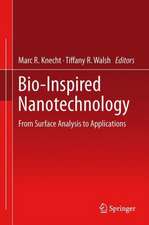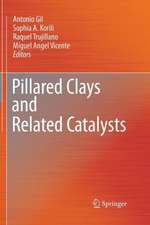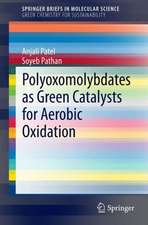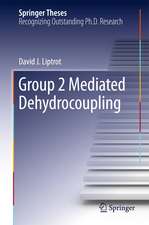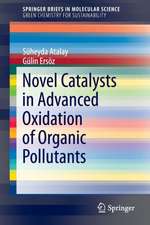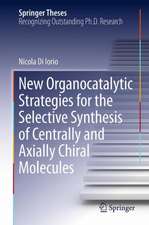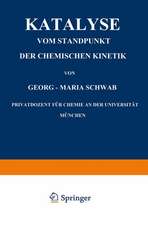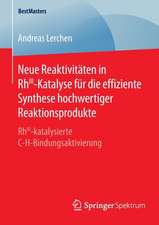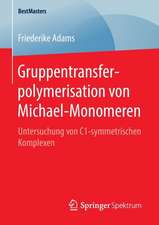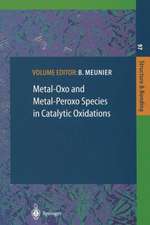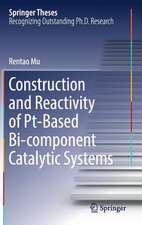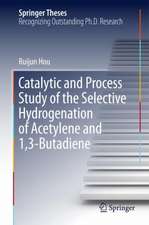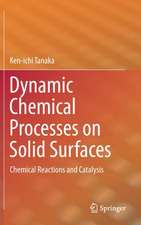Catalysis and the Mechanism of Methane Conversion to Chemicals: C-C and C-O Bonds Formation Using Heterogeneous, Homogenous, and Biological Catalysts
Autor Toshihide Baba, Akimitsu Miyajien Limba Engleză Paperback – 20 apr 2021
| Toate formatele și edițiile | Preț | Express |
|---|---|---|
| Paperback (1) | 941.50 lei 6-8 săpt. | |
| Springer Nature Singapore – 20 apr 2021 | 941.50 lei 6-8 săpt. | |
| Hardback (1) | 947.50 lei 6-8 săpt. | |
| Springer Nature Singapore – 20 apr 2020 | 947.50 lei 6-8 săpt. |
Preț: 941.50 lei
Preț vechi: 1148.18 lei
-18% Nou
Puncte Express: 1412
Preț estimativ în valută:
180.15€ • 188.11$ • 148.77£
180.15€ • 188.11$ • 148.77£
Carte tipărită la comandă
Livrare economică 15-29 aprilie
Preluare comenzi: 021 569.72.76
Specificații
ISBN-13: 9789811541346
ISBN-10: 9811541345
Ilustrații: XII, 220 p. 179 illus., 11 illus. in color.
Dimensiuni: 155 x 235 mm
Greutate: 0.33 kg
Ediția:1st ed. 2020
Editura: Springer Nature Singapore
Colecția Springer
Locul publicării:Singapore, Singapore
ISBN-10: 9811541345
Ilustrații: XII, 220 p. 179 illus., 11 illus. in color.
Dimensiuni: 155 x 235 mm
Greutate: 0.33 kg
Ediția:1st ed. 2020
Editura: Springer Nature Singapore
Colecția Springer
Locul publicării:Singapore, Singapore
Cuprins
Overview of direct methane conversion to chemicals with C–O and C–C bonds.- Selective production of methanol from methane and molecular oxygen at atmospheric temperature and pressure using methane monooxygenases.- Heterogeneous and homogeneous catalytic partial oxidations of methane to methanol and its derivatives.- Application of biocatalysts for the production of methanol from methane.- C–C bond formation via the condensation of methane in the presence or absence of oxygen.- Conversion of methane to aromatic hydrocarbons.- C–C bond formation via carbocations in the methane conversion under non-oxidative conditions
Notă biografică
Dr. Toshihide Baba received his Ph. D. from Tokyo Institute of Technology, Japan, in 1983. His research interests include catalytic chemistry and physical chemistry to reveal reaction mechanism and catalysis. He is currently Professor at Tokyo Institute of Technology. He published more than 200 articles and contributed to 5 books. He won the Japan Petroleum Institute Award in 2017.
Dr. Akimitsu Miyaji received his Ph. D. from Tokyo Institute of Technology, Japan, in 2004. His research interests include biochemistry and bioengineering of methane monooxygenase, mechanism of molecular recognition and product selectivity of alkane monooxygenase, and oxidative stress due to the oxidation reaction with tyrosinase. He is currently Assistant Professor at Tokyo Institute of Technology. He published 75 articles and contributed to 2 books. He won the Japan Petroleum Institute Award for Encouragement of Research and Development in 2014. He has 13 years of teaching experience at Tokyo Institute of Technology, and 1 year at Shibaura Institute of Technology.
Dr. Akimitsu Miyaji received his Ph. D. from Tokyo Institute of Technology, Japan, in 2004. His research interests include biochemistry and bioengineering of methane monooxygenase, mechanism of molecular recognition and product selectivity of alkane monooxygenase, and oxidative stress due to the oxidation reaction with tyrosinase. He is currently Assistant Professor at Tokyo Institute of Technology. He published 75 articles and contributed to 2 books. He won the Japan Petroleum Institute Award for Encouragement of Research and Development in 2014. He has 13 years of teaching experience at Tokyo Institute of Technology, and 1 year at Shibaura Institute of Technology.
Textul de pe ultima copertă
This book introduces various types of reactions to produce chemicals by the direct conversion of methane from the point of view of mechanistic and functional aspects. The chemicals produced from methane are aliphatic and aromatic hydrocarbons such as propylene and benzene, and methanol. These chemicals are created by using homogeneous catalysts, heterogeneous catalysts such as zeolites, and biocatalysts such as enzymes. Various examples of methane conversion reactions that are discussed have been chosen to illustrate how heterogeneous and homogenous catalysts and biocatalysts and/or their reaction environments control the formation of highly energetic species from methane contributing to C-C and C-O bond formation.
Caracteristici
Summarizes fundamental issues in methane conversion for novices in the field Illustrates examples of methane conversion without the boundary of chemical and biological catalysts Uses basic organic and physical chemistry to explain methane conversion reactions



